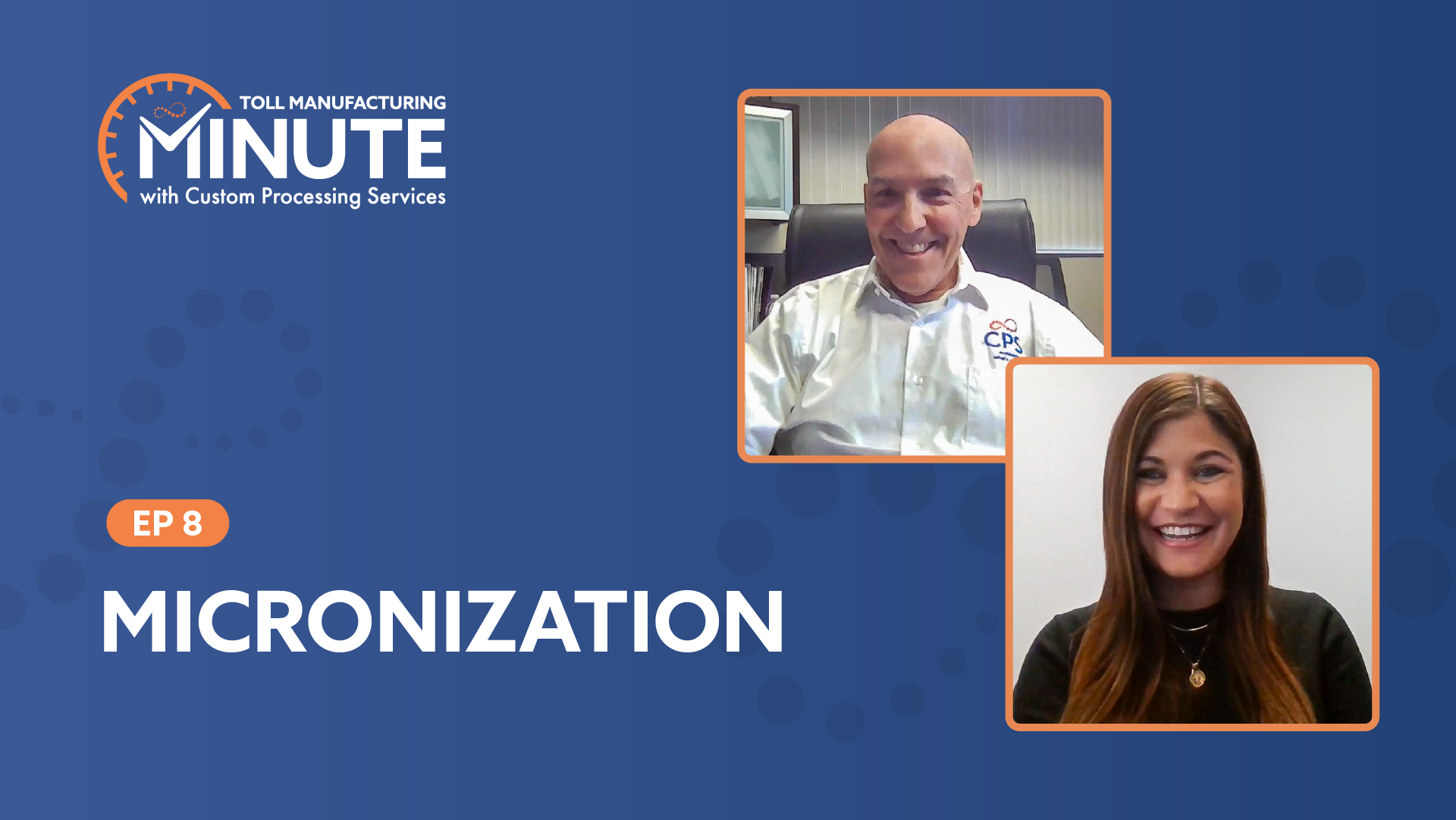Toll Manufacturing Minute with CPS: Micronization

From pharmaceuticals and specialty chemicals to electric vehicle (EV) batteries and 3D printing, micronization plays a crucial role in modern manufacturing. By reducing particle sizes to the micrometer or even nanometer scale, micronization enhances product performance, improves manufacturing efficiency, and helps companies meet strict industry requirements.
In this podcast episode, CPS Vice President Jeff Klinger explored the science, applications, and challenges of micronization.
Below, we’ve captured key takeaways from the conversation, including why particle size matters, how different micronization techniques work, and what manufacturers should consider when outsourcing micronization services.
What Is Micronization?
Micronization is the process of reducing material particle size to between 1 and 10 microns. To put that into perspective, a human hair is about 70 microns in diameter, meaning micronized particles are far smaller than what the human eye can see.
This ultra-fine size reduction improves material behavior, reactivity, and efficiency, making it an essential process in industries where particle uniformity and performance are critical.
How Industries Uniquely Benefit from Micronization
Micronization primarily enhances the functional properties of materials, providing benefits that underpin successful applications in major industries in unique ways, including:
Pharmaceuticals & Life Sciences
- Increased bioavailability: Micronized drugs are absorbed more efficiently, increasing efficacy
- Improved solubility: Micronization enhances dissolution of otherwise poorly water-soluble drugs
- Amplified respiratory applications: Fine and ultra-fine powders ensure proper lung absorption for inhalers and other respiratory treatments
Food & Nutritional Products
- Better texture/mouthfeel: Micronization improves the consistency of powders used in food and beverage formulations
- Greater nutraceutical absorption: Finer particles increase surface area, allowing the human body to effectively absorb vitamins and minerals
Specialty Chemicals and Coatings
- Improved dispersion: Micronization enables uniform chemical mixing in coatings, inks, and adhesives
- Better performance in industrial applications: Smaller particles increase reactivity to maximize chemical processes and interactions
Electric Vehicle (EV) Batteries
- Higher energy efficiency: Micronized materials in lithium-ion batteries increase conductivity and reaction speed
- Lower material waste: Smaller particles mean better yield and utilization of often costly raw materials
3D Printing & Additive Manufacturing
- Precise powder consistency: Powder fineness and uniformity dictates the quality of 3D printing
- Better print resolution: Smaller particles help create smoother, more accurate prints
How Micronization Works: Key Techniques
Different materials require different micronization methods. Choosing the right milling technique depends on factors like material structure, desired particle size, and application requirements.
There are several options, with these four typically being the most common:
- Jet Milling creates very fine contamination-free particles ideal for pharmaceuticals, speciality chemicals, and battery materials requiring precision particle size control
- Wet Milling suspends and grinds particles in a liquid slurry, achieving sub-micron and nanometer-sized particle reduction that stabilizes dispersions in many pharmaceutical and food applications
- Mechanical Milling produces micron-sized particles that aren’t as fine as those achieved in jet or wet milling, which suits many food processing, industrial powder, and bulk material handling applications
- Cryogenic Milling uses liquid nitrogen to freeze materials susceptible to heat degradation during processing such as elastomers and some polymers, and is also ideal for processing sticky, tough, or soft materials
Micronization Challenges
While micronization is a popular tolling process, some materials are inherently difficult — but not necessarily impossible — to process:
- Hygroscopic (moisture-absorbing) materials can agglomerate (clump and stick), making particle uniformity hard to achieve
- Highly elastic materials such as rubbers and some polymers naturally resist milling because of softness and flexibility, thereby requiring cryogenic processing
- Highly explosive or reactive powders require processing in inert gas environments to reduce the risk of combustibility and maximize safe handling
In cases where traditional micronization won’t work, the experience of toll processors is vital. Tolling partners such as CPS that offer in-house analytical lab testing and engineering provide a distinct advantage in customizing approaches that achieve the desired result.
Maximizing Yield
That same expertise applies to the challenge of maximizing yield, especially when working with high-value materials such as certain pharmaceutical ingredients and critical minerals (cobalt, lithium, manganese, etc.) found in EV batteries.
Toll processors attuned to maximum yield and minimum waste have measures in place to ensure both are carried out, including:
- Aligning the right equipment and process parameters for optimal efficiencies
- Using advanced collection systems to capture as much usable material as possible
- Applying strict quality control standards to maintain product integrity and reduce waste incurred by contaminated or defective materials
By partnering with a toll processor proven in overcoming micronization challenges and optimizing milling efficiencies, manufacturers can reduce costs, improve consistency, and get better performance from their materials.
Next Steps
With micronization or any other particle size reduction goal, details matter. Knowing the ins and outs of your project prior to engaging your toll processing partner can go a long way in asking the right questions, managing time and costs, and ensuring accurate scope.
Use our Grinding Project Application Checklist to consider all aspects of your project and achieve successful outcomes. Download your copy now.


.png?width=100&height=110&name=CPS-Logo-rgb-no-callout%20(1).png)
